![]()
![]()
![]()
Use LEFT and RIGHT arrow keys to navigate between flashcards;
Use UP and DOWN arrow keys to flip the card;
H to show hint;
A reads text to speech;
112 Cards in this Set
- Front
- Back
|
What type of tissue lines the stomach? |
Simple columnar epithelium |
|
|
For how long does food stay in the stomach? |
2-6hrs |
|
|
Mucous membrane of the stomach |
Inner lining Contains gastric glands |
|
|
Gastric glands |
Glands within the mucus membrane of the stomach Contain gastric pits |
|
|
Gastric pits |
Openings of the gastric glands into the gastric cavity |
|
|
What types of cells are the gastric glands made of? |
1. Mucous cells 2. Chief Cells 3. Parietal cells |
|
|
Mucous cells of the stomach |
- secretes mucous - forms a protective lining for the stomach wall against stomach acid |
|
|
Stomach acid |
HCl Hydrochloric acid |
|
|
Chief cells |
Secrete pepsinogen |
|
|
Pepsinogen |
Converts to pepsin when it comes in contact with hydrochloric acid |
|
|
Parietal cells |
- secretes HCl - secretes intrinsic factor |
|
|
HCl |
Hydrochloric Acid Gives the stomach its acidic environment |
|
|
Intrinsic Factor |
Necessary for proper absorption of vitamin B12 |
|
|
Rugae |
Folds of tissue within the empty stomach Increases total area of the stomach and allows it to stretch |
|
|
Gastric Secretions |
Released when a person thinks about, sees, smells, and tastes food |
|
|
Stages of cephalic secretions |
1. Cephalic phase 2. Gastric phase 3. Intestinal phase |
|
|
Cephalic phase |
Gastric secretions that are released when a person thinks about, sees, smells, and tastes food
Increased salivary secretion |
|
|
Gastric phase |
Begins when food enters the stomach The presence of food stimulates the release of gastrin Increased gastric gland secretion, enzyme secretion, and stomach motility |
|
|
Gastrin |
A hormone that stimulates the production of gastric juices |
|
|
Intestinal phase |
Begins when food passes through the pyloric sphincter and enters your duodenum
As the duodenum fills with chyme, the enterogastric reflex begins Gastric secretions of the stomach are eventually inhibited |
|
|
Enterogastric reflex |
As the duodenum is stretched, gastric secretions and motility are inhibited to prevent overfilling of the duodenum |
|
|
pH of the stomach |
About 1 |
|
|
Cholecystokinin and secretin |
Hormones that cause a decrease in gastric motility and an inhibition of gastric gland secretion |
|
|
Types of muscular movements of the GI tract |
1. Peristalsis 2. Segmentation |
|
|
Peristalsis |
Wave-like muscular contractions that propel the movement of food or chyme along the digestive tract |
|
|
Segmentation |
Localized contractions of the stomach and the small intestine that result in the mixing of chyme and digestive juices |
|
|
What type of tissue lines the small intestine? |
Simple columnar epithelium |
|
|
Structures of the small intestine that serve to increase surface area |
1. Plicae circulares 2. Intestinal villi 3. Microvilli |
|
|
Plicae circulares |
Circular folds within the small intestine that are extensions of the submucosa and mucous membrane |
|
|
Intestinal villi |
Numerous tiny projections of mucous membrane coming off of the plicae circulares |
|
|
Microvilli |
Microscopic extensions of the epithelial cells of the mucous membrane |
|
|
Secretions of the small intestine |
1. Mucous from the Brunner's glands 2. Digestive enzymes from the mucosal cells 3. Mucous from goblet cells |
|
|
Function of mucous secreted from the Brunner's glands |
Protects the inner lining of the small intestine |
|
|
Digestive enzymes secreted by mucosal cells within the small intestine |
1. Peptidases 2. Sucrase 3. Lactase 4. Maltase 5. Lipase |
|
|
How are secretions of the small intestine regulated? |
By the release of chyme from the stomach into the duodenum As chyme enters the duodenum, secretions increase |
|
|
The largest amount of absorption occurs in the ____ |
Small intestine |
|
|
What are the mechanisms of absorption into the blood for monosaccharides? |
active transport and diffusion |
|
|
What is the mechanism of absorption for amino acids? |
Active transport |
|
|
What are the mechanisms of absorption into the blood for electrolytes? |
Diffusion and active transport |
|
|
What are the mechanisms of absorption into the blood for water? |
Osmosis |
|
|
What are the mechanisms of absorption into the blood for fatty acids? |
Mostly diffusion In epithelial cells, most are converted back into fats: - these fats become organized into chylomicrons - chylomicrons travel into lacteals, which transport by lymph to the blood - Chylomicrons reach the muscle and adipose tissue where they are broken down into fatty acids and glycerol |
|
|
After the chylomicrons are broken down, what happens to the products and remnants? |
Fatty acids and glycerol: either stored or used as energy sources Remnants of chylomicrons: destroyed by the liver by lysosomal activity |
|
|
Chylomicrons |
A type of lipoprotein |
|
|
Lipoprotein |
Fats that are organized into clusters and encased in protein |
|
|
Lacteals |
Lymphatic capillaries |
|
|
Diarrhea |
A condition in which stools are watery due to frequent defecation The rapid movement of chyme does not allow for the normal absorption of water, nutrients, and electrolytes |
|
|
Peyer's Patches |
Accumulations of lymph nodules within the mucosal lining of the ileum |
|
|
What is a distinguishing feature of the large intestine? |
Taenia coli |
|
|
Taenia coli |
A unique arrangement of longitudinal fibers, grouped into tape-like strips |
|
|
Main functions of the large intestine |
1. Absorption of water and electrolytes from the remaining chyme 2. The formation and storage of feces 3. Contains bacteria which help to make certain vitamins |
|
|
Pouches of the large intestine |
Haustra |
|
|
Example of a vitamin synthesized in the large intestine and its function in the body |
Vitamin K Necessary for proper blood clotting |
|
|
Defecation |
The release of feces to the exterior of the body |
|
|
What triggers the defecation reflex? |
• A voluntary deep breath and contracting the abdominal wall muscles • this causes feces to be forced into the rectum, triggering the reflex |
|
|
What are the events of the defecation reflex? |
1. Parastaltic waves are stimulated in the descending colon 2. Internal anal sphincter relaxes 3. An additional deep breath causes the abdominal muscles to contract and the diaphragm to lower, both of which create pressure on the rectum 4. External anal sphincter is signaled to relax and feces exits the body |
|
|
What type of tissue makes up the internal anal sphincter? |
Smooth muscle |
|
|
What type of tissue makes up the external anal sphincter? |
Skeletal muscle |
|
|
Where is the pancreas located? |
Behind the stomach |
|
|
What are examples of secretions of the pancreas? |
Insulin Glucagon Digestive enzymes |
|
|
Insulin |
Lowers blood sugar levels by converting glucose into glycogen |
|
|
Glycogen |
A form of sugar that is stored in the liver and skeletal muscle |
|
|
Glucagon |
Raises blood sugar levels by converting glycogen into glucose |
|
|
Pancreatic digestive enzymes |
1. Amylase 2. Lipase 3. Trypsin 4. Chymotrypsin 5. Carboxypeptidase |
|
|
What influences the secretions from the pancreas? |
Secretin Cholecystokinin |
|
|
Appendix |
Worm-like structure that opens into the cecum |
|
|
Function of your appendix |
Seems to have immune function. No known digestive function |
|
|
Digestive function of liver |
The production of bile |
|
|
Bile composition |
1. Bile salts 2. Bile pigment 3. Cholesterol 4. Water |
|
|
Bile pigments |
Bilirubin and biliverdin Hemoglobin breakdown products |
|
|
Function of bile |
Emulsification Aiding in the absorption of fatty acids and cholesterol |
|
|
Emulsification |
The breaking apart of large fat globules into smaller fat droplets Allows for more efficient enzymatic digestion of fat |
|
|
Kupffer cells |
Large phagocytic cells in the liver that help engulf entering pathogens |
|
|
Gallbladder |
Pear shaped organ located on the inferior surface of the liver Functions to store and concentrate bile |
|
|
What regulates the release of bile? |
The hormone cholecystokinin |
|
|
Appendicitis |
Inflammation of the appendix |
|
|
Appendectomy |
The removal of the appendix |
|
|
Gallstones |
Most commonly caused when cholesterol precipitates out of the bile |
|
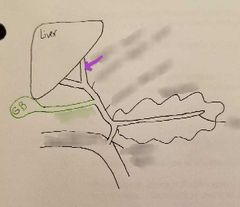
|
Right hepatic duct |
|

|
Common hepatic duct |
|
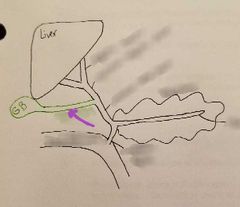
|
Cystic duct |
|
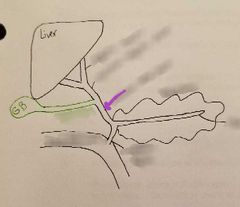
|
Common bile duct |
|
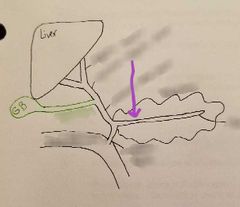
|
Pancreatic duct |
|
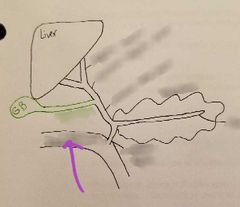
|
Duodenum |
|
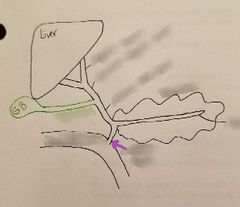
|
Duodenal papilla |
|
|
Digestion |
The process by which food is broken down and the nutrients are absorbed for use by the body's cells |
|
|
Mechanical digestion |
The tearing/shredding of foods Accomplished primarily by teeth |
|
|
Chemical digestion |
A chemical process in which enzymes are used to speed up hydrolysis of bonds in food compounds |
|
|
What are polypeptides broken down into? |
Dipeptides |
|
|
Dipeptides |
Short chains of AA Broken down into AA, which are absorbed and delivered to body cells |
|
|
Function of digestive enzymes |
Catalyze hydrolysis |
|
|
What tissue lines the oral cavity? |
Stratified squamous epithelium |
|
|
Salivary glands |
Parotid glands Submandibular glands Sublingual gland |
|
|
Parotid glands |
2 of them Exocrine glands (have ducts) In cheeks |
|
|
Submandibular glands |
2 of them Below mandible |
|
|
Sublingual gland |
1 gland Under the tongue |
|
|
Function of saliva |
Helps to keep the oral cavity tissues moistened
Helps form a bolus Helps to dissolve chemicals in the food that we eat |
|
|
Bolus |
Small, round mass of food that we swallow |
|
|
Types of saliva |
Serous saliva Mucous saliva |
|
|
Serous saliva |
Involved in moisten function Involved in dissolving chemicals |
|
|
Mucous saliva |
Helps form a bolus |
|
|
Tissue in tongue |
Composed of skeletal muscle Lined with stratified squamous epithelium |
|
|
Type of tissue in gingiva |
Stratified squamous epithelium |
|
|
Gingivitis |
Inflammation of the gingiva |
|
|
Periodontitis |
Inflammation of the periodontal ligament and associated structures |
|
|
Digestive tract movement |
Peristalsis Segmentation |
|
|
Peristalsis |
Propels the bolus, chyme, feces, in forward, "wave like" contractions |
|
|
Segmentation |
Back and forth contractions Results in a mixing action |
|
|
Wisdom teeth |
3rd molars |
|
|
Soft tissue impaction |
Tooth comes through the bone but not fully through the gingiva |
|
|
Bony impaction |
Tooth fails to erupt through the bone |
|
|
Dental Caries |
Tooth disease that results in the formation of tooth defects AKA cavities |
|
|
Plaque |
A sticky film of bacteria on the surface of the teeth that release acids #1 cause of cavities |

